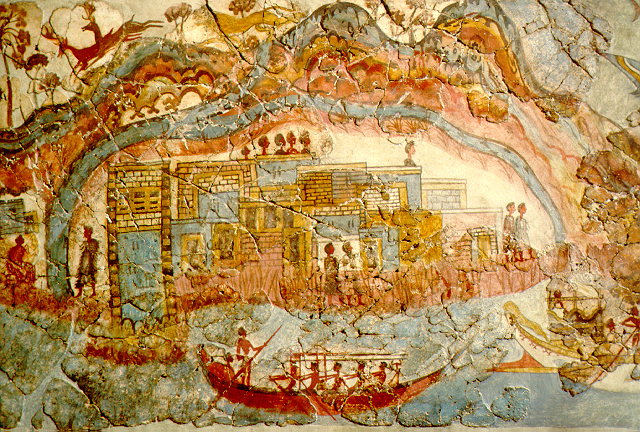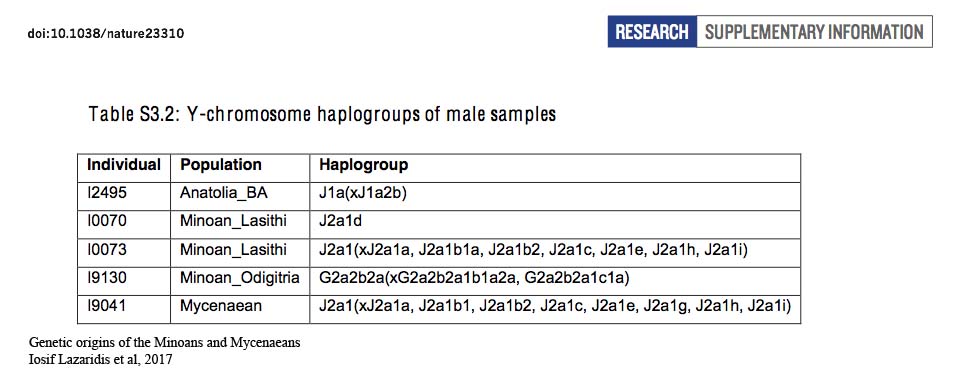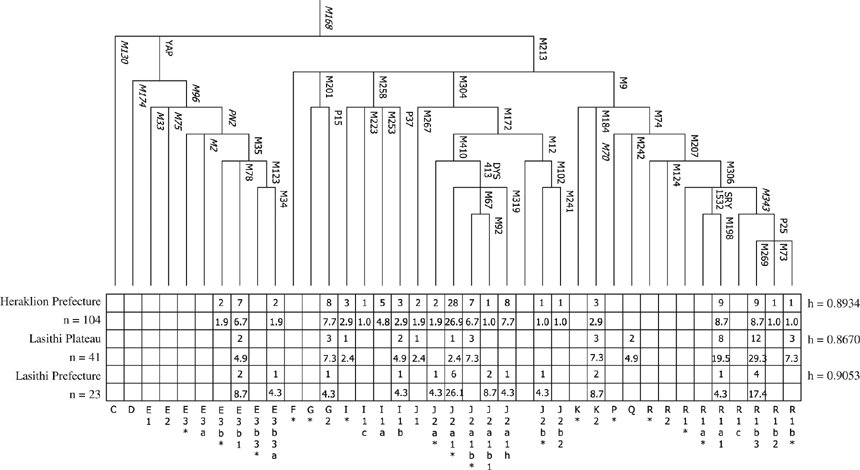Eurocentrists never give up trying to "white out", Blacks from ancient history. Many of the Minoan murals were repainted to make them look more European. But The Minoans were Blacks.

Population genetics can not change history and archaeology except in the mind of the confused and promoters of Eurocentrism. The Greeks made it clear the Minoans came from Africa and were descendants of the Garamantes.
The Garamantes founded civilization in Minoa, or ancient Crete.The Garamantes were Mande speakers not Berbers.
The Tuareg did not come from the Fezzan, they originated in the East. According to Tuareg tradition they originated in the Tafilalt or Tafilet (Arabic: تافيلالت) a important oasis of the Moroccan Sahara, and migrated from there to the Fezzan.
The Ancient Minoans: Keftiu were Mande Speakers
Every since Arthur Evans discovered the Hieroglyphic and Linear A writing of Crete there has been a search for the authors of this writing.
Some Grecian traditions indicate that Libyans (called Garamante) formerly lived on Crete. This suggest that the Eteocretans may have spoken one of the ancient languages of Libya.
Sources agree that Garama was name of their capital city. Garamante was the name for the tribe.
Garama was the name of the capital city of the Garamantes. Pliny the Elder wrote"clarissimumque Garama caput Garamantum, the "well known Garam capital, of the Garamantes".See: www.saudiaramcoworld.com/issue/20....ert.kingdom.htm
A major group from Libya that settled Crete were the Garamante. Robert Graves in (Vol.1, pp.33-35) maintains that the Garamante originally lived in the Fezzan and fused with the inhabitants of the Upper Niger region of West Africa.
This theory is interesting because the chariot routes from the Garama, in the Fezzan terminated at the Niger river. In addition, the Cretan term for king "Minos", agrees with the Mande/Manding word for ruler "Mansa". Both these terms share consonantal agreement : M N S.
The name Garamante, illustrates affinity to Mande morphology and grammar. The Mande language is a member of the Niger-Congo group of languages. The name for the Manding tribe called "Mande", means Ma 'mother, and nde 'children', can be interpreted as "Children of Ma", or "Mothers children " (descent among this group is matrilineal) . The word Garamante,can be broken down into Malinke-Bambara into the following monosyllabic words Ga 'hearth', arid, hot'; Mante/Mande , the name of the Mande speaking tribes. This means that the term: Garamante, can be interpreted as "Mande of the Arid lands" or "Arid lands of the children of Ma". This last term is quite interesting because by the time the Greeks and Romans learned about the Garamante, the Fezzan was becoming increasingly arid.

Keftiu
The Egyptians called the Cretans Keftiu. There is agreement between the Keftiu names recorded by Egyptian scribes (T.E. Peet, "The Egyptian writing board BM5647 bearing Keftiu names". In , (ed.) by S Casson (Oxford, 1927, 90-99)), and Manding names.
The root kef-, in Keftiu, probably is Ke'be, the name of a Manding clan , plus the locative suffix {i-} used to give the affirmative sense, plus the plural suffix for names {u-}, and the {-te} suffixial element used to denote place names, nationalities and to form words.
On the Egyptian writing board there are eight Keftiu names. These names agree with Manding names:
Keftiu....... Manding
sh h.r........ Sye
Nsy ..........Nsye
'ksh .........Nkyi
Pnrt Pe,..... Beni (name for twins)
'dm ..........Demba
Rs............. Rsa
This analogy between Keftiu and Manding names is startling.
In conclusion, the evidence of similarity between Keftiu names and names from the Manding languages appear to support Graves view that the Eteocretans, who early settled Crete may have spoken a language similar to the Mande people who live near the Niger. Conseqently, there is every possibility that the Linear A script used by the Keftiu, which is analogous to the Libyco Berber writing used by the Proto-Mande .This is further support to Cambell-Dunn' s hypothesis that the Minoans spoke a Niger-Congo language.
In addition, because the Keftiu were Africans, the haplogroups carried by the Minoans would have been African haplogroups.

As a result, when we find mtDNA U,T,N1 and K among the Anatolians, it was just a reflection of the Blacks/Kushites that dominated Anatolia

Consequently, when we find that the Minoans carried haplogroups H (43.2%), T (18.9%), K (16.2%) and I (8.1%). Haplogroups U5a, W, J2, U, X and J were each identified in a single individual. The results correspond to the Anatolian mtDNA.
The Mande speakers, include the Djola and Mandekan of the geneticist carry 2% Eurasian admixture. The people in Mali carry the N and H haplogroups.
.

.
The highest concentration of U5 is found among Berbers in NWA . It is also carried by Mande spekers and Fulani in West Africa . The Djola, Mande speakers also carry mtDNA M1, H and N. See Alexandra Rosa, et al, MtDNA Profile of West Africa Guineans: Towards a Better Understanding of the Senegambia, http://onlinelibrary.wiley.com/doi/10.1046/j.1529-8817.2004.00100.x/full
The U5 haplogroup carried by the Mande, like other SSWA is characterized by 16189,16192,16270 and 16320.
The presence of hg U5, M1, N and H among the Mande speakers supports the linguistic evidence concerning the Keftiu.
The Y-chromosomes of Cretans also indicate the Cretans were Blacks Laisel Martinez et al , Paleolithic Y-haplogroup heritage predominates in a Cretan highland plateau, Eur J Hum Genet. 2007 http://www.nature.com/ejhg/journal/v15/n4/full/5201769a.html provides a detailed discussion of the y-chromosomes in Crete.
The presence of y-chromosomes R1b, T, K and H in Crete indicate that the Cretans were Black.
.

The genomic data from this period is important because the people of Abusir at this time would have been primarily Egyptian. As a result, the mtDNA carried by the Egyptians confirms the reality that the so-called Eurasian haplogroups are nothing more than African haplogroups.
.

.
In Schuenemann et al, 2017, there were 100 mummies in the study. A total of 27 mummies were dated between 992-749BC. In Figure 1, you can see the clades carried by these Egyptians. Below are the frequencies of the haplogroups among Egyptians at this time:
- Haplogroup Frequency
U 18.5
T 22.2
J 18.5
X 0.0675
M1a 0.0675
H 0.0675
I 0.0675
HV 0.037
RO 0.037
K 0.037
N 0.037
The presence of these haplogroups among the Abusir population shows that the U,T, and J clades had a high frequency among the Egyptians, and that many of the so called Middle East clades were already present in Lower Egypt before the Greco-Romans, Turks and etc. ruled Egypt.
As a result, the finding of mtDNA U,T,J and N clades, and the Y-Chromosome R1 among, Anatolians, Cretans and Lower Egyptians explains the close relationship between the Minoans,and Anatolians. All of these people were Khas=Kushites, who had come from Upper Egypt and the Fezzan.
